ST PETER'S QUARTER TRAILS - ALBERT STREET
ST PETER’S QUARTER TRAIL 4
St Peter’s Quarter stylish and absorbing
Looking across Albert Street
The culverting of Markeaton Brook created a new street, Albert Street that ran from the former St. Peter’s Bridge at the intersection of Peter’s Street and the Corn Market towards the Morledge. As you walk along Albert Street, The Corn Exchange is the most eye-catching building. It was built in 1861, opening the next year, following long-standing complaints that corn dealers were obstructing the footpaths in the Corn Market. It became the Palace Theatre of Varieties in 1897 and 22 years later the Palais de Danse. Dancing was advertised as ‘twice nightly’, but this was not really correct as the first session started at 3 pm at a cost of 1s 6d and the second at 7.30 pm costing 2s 6d. Friday was a special night, where all those present had to pay 5 shillings and evening dress was compulsory. In 1914, the dance hall closed at the outbreak of the war and after the war ended, it reverted to the Palais de Danse again.
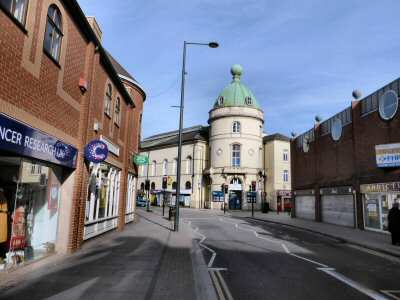
During the 1900s, the Corn Exchange contained luxurious lounges, tea and supper rooms, until the Derby Evening Telegraph took it over for offices in 1929. After nearly 50 years of costly circulation wars, the Telegraph merged with its rival, the Express, on 29 January 1932. The Express was owned by Allied Northern Newspapers, and Northcliffe Newspapers owned the Derby Telegraph. The two papers were combined and the joint paper was published at Northcliffe House, the new name given to the Corn Exchange.
As new technology was introduced, it became obvious that Northcliffe House was too small to accommodate all the equipment and the move to new premises, on the banks of the River Derwent, began at the end of 1979. In 2014, the paper moved again to Siddals Road closer to the centre of the city.
For years market stalls lined the Morledge until the land was acquired for the new bus station. An outdoor market was then set up next to the bus station and was opened on 5 May 1933 by the Mayor, Alderman A. Moult. At that time it was one of the most up-to-date in the Midlands. It closed when the indoor Eagle Centre Market opened on 20 November 1975, amongst much controversy.
The Eagle Centre, when it was opened, provided Derby with its first large indoor shopping mall. Refurbishment followed before it was eventually transformed over a three-year period into the new Westfield Derby (now under new management), losing its old name as part of the re-branding exercise. It opened to the public on 9 October 2007. This eagerly awaited event saw 150,000 people come through the centre’s doors in the first eight hours of trading. The busiest retail day in Derby’s history!
The Morledge
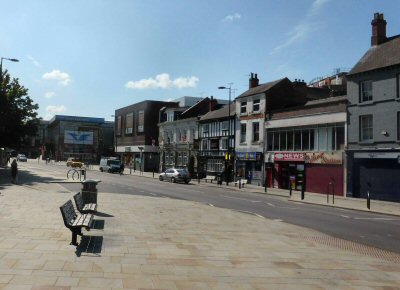
In 1154, King Henry II granted Derby a charter which gave the town the right to hold markets. As a consequence Derby developed a tradition of holding a weekly market for cattle, sheep and pigs. Until 1861, markets were held at the Morledge, when they were moved to the Holmes, on the northern side of what later became the bus station. Shortly after its centenary celebrations in 1962 when the Inner Ring Road was constructed, the market moved again to a purpose-built cattle market on Chequers Road.
Once it was decided that the Morledge was to be widened and cleared the popular charter fairs had to go. The last fair to be held there was at Easter, 1931. An open market was set up on the Morledge two years later when it moved from the marketplace to a site next to the bus station, where it remained until the completion of the Eagle Centre. It closed when the indoor market at the Eagle Centre opened on November 20, 1975, despite much controversy. Stallholders and customers accused the council of making change for change’s sake and several traders claimed the new market would be “a town planner’s daydream and a trader’s nightmare”.
The Shot Tower Information Board
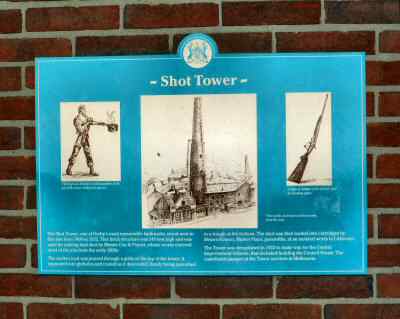
One of Derby’s most famous landmarks, before it was demolished in 1932, was the Shot Tower on the Morledge, which is remembered today by an information board on the front of the shop next to the Council House Car Park. Molten lead was poured through a grille at the top of the tower, separating into globules and cooling as it descended, finally being cooled in a trough at the bottom. Rosson’s, the gunsmiths, whose business was in the Market Place, then had the shot loaded into cartridges at works in Littleover, which is now a private house in what is a built-up area.
The Shot Tower was 149.5 feet high, 10 feet wide at the top and 27 ft 11 inches wide at the bottom. It was demolished in 1932 as part of the Central Improvement Scheme, 123 years after it had been built for Messrs Cox and Poyser. The walls were 14 inches thick at the top and 3 feet 2 inches thick at the base and 196 steps were covering a distance of 210 feet, the tower consisting of approximately 250,000 bricks.
The Noah’s Ark Public House
Established in the first half of the 1700s, for 30 years the pub operated alongside another hostelry bearing the same name, until in 1873 the adjacent pub changed its name. The only concession made to avoid confusion before 1873 was adding ‘Old’ to the title, in 1852. This has now been dropped.
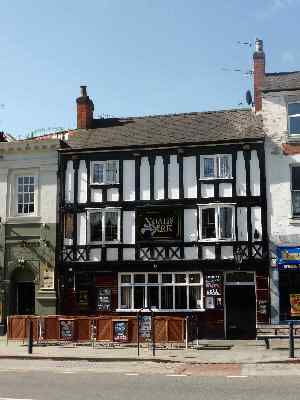
The pub’s name probably originates from Noah Bullock, a 17th-century gentleman, who built an ark for himself and his family and moored it on the River Derwent, just above St Mary’s Bridge. When local people saw the ark they laughed at Noah and he became a figure of fun. This did not bother him as he thought he had created the perfect cover for his illegal trade of counterfeiting coins. As should the law visit him, he could easily conceal the evidence in the dark and muddy waters of the river.
Eventually, news spread of his illicit trade and he was summoned to appear before Derby magistrate Sir Simon Degge at his office. Fortunately, Noah was a friend of Sir Simon’s and when questioned said nothing until after Sir Simon had promised that “no evil should befall him, provided that he relinquished the trade”. After he had heard those words, he admitted that he was a counterfeiter and agreed to abandon his criminal activities. He destroyed his ark and kept his promise not to continue his illegal trade, to escape the hangman’s noose as his crime was a capital offence in those days.
Derby Crown Court
The Crown Court in St Mary’s Gate closed in 1989 and was transferred to the newly built Crown Court on the Morledge. Following the closure and several years of uncertainty, the old County Court has been replaced by the city’s Magistrates Court.
In the mid-17th century, St Mary’s Gate had been selected as a suitable place to build a Shire Hall, which later became known as the County Hall. It was designed by George Eaton of Etwall and completed in 1659. Originally it was used for concerts, plays, and gatherings, as well as courts and assizes. In 1714, when the new Assembly Rooms were built, the buildings became exclusively a Crown Court. An inn was added on one side around 1795 and Judges’ Lodgings on the other side in 1811.
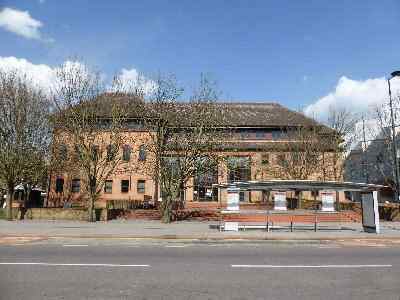
Assize Courts originated in the reign of Henry II and were courts with a judge and jury. They sat with the authority of the monarch, bringing the King’s Justice to the people. Initially, the assizes for both Derbyshire and Nottinghamshire were held in Nottingham. However, in 1328, the Sheriff of Nottingham was instructed to provide suitable facilities in Derby. The joint assizes were then held alternatively in Nottingham and Derby, until 1566, when separate assizes were held.
Riverlights
Derby’s first bus station was comparatively small and was located on Albert Street. It was owned by the Trent Motor Company and was operational from 1923 to 1933 when services were transferred to the newly built bus station on the Morledge. This was designed by the Borough Architect, Charles Aslin and opened on 2 October 1933 despite considerable controversy amongst the public who objected to the removal of other facilities. It provided a prototype for a drive-in/drive-out bus station, which was modelled on the concept used for railway stations. Built of concrete using cantilever construction, the style was one that others copied. It had a café, newsagents and offices incorporated in Art-Deco style buildings.
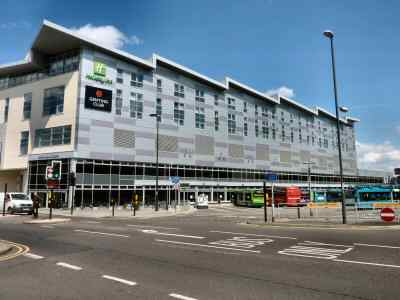
Initially, the bus station received widespread praise for its trendsetting design, but criticism soon followed about the dangers of crossing the traffic lanes between platforms because of the curved nature of the station. It was also pointed out at the time that despite clearly marked crossing points, passengers were still having problems.
The bus station was Derby’s best example of ‘Art Deco’ architecture and when the city council proposed its replacement, there was considerable opposition. It was thought to be out of date for modern-day requirements and the council wanted a station better suited for modern-day buses and offering greater comfort for the travelling public. The eventual outcome was that the bus station was demolished and a new development called Riverlights was commenced. The bus station section of the new development was opened in March 2010 and later two hotels and a casino were added.
Longbridge Weir Hydro Power House
The Hydro Power House opened on 20 May 2013, on the banks of the River Derwent behind the Riverlights complex. It has been named after the bridge that used to cross the River Derwent near the weir. The hydro exists primarily to power Derby City Council House. This is achieved by water being passed through a turbine to produce electricity before being returned to the river. In electricity terms, it generates enough electricity to supply the needs of the Council Offices, with any surplus being sold to the National Grid.
In the past, it was the textile mills, between Matlock Bath and Derby (including the Silk Mill) that relied on water power from the River Derwent to drive their machinery. Similar schemes to the Longbridge Weir Project to harness water power from the Derwent may follow and make the river once again an important producer of power, this time electricity.
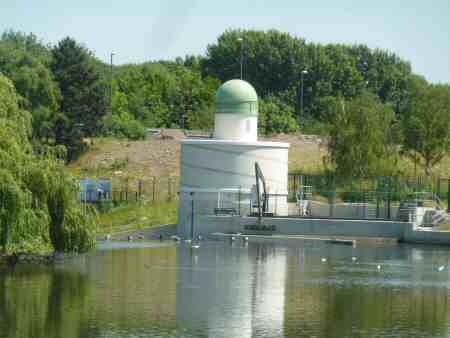
Originally, Longbridge took the towpath of the Derby Canal across the River Derwent to connect with both arms of the canal on opposite sides of the river. Canals were a very important factor in providing transportation for cotton and Walter Evans of the Boar’s Head Cotton Mills at Darley Abbey was appointed treasurer of Derby Canal Company, which enabled him to ensure the mills at Darley Abbey benefited from the canal.
Raw cotton arrived at the ports of London, Liverpool and Hull and was transported using inland waterways to its destination. The problem was that initially, the canal did not quite reach the mill at Darley Abbey. It was solved by constructing a short branch canal, called the Phoenix, to avoid the weir. The canal had two locks, the White Bear Lock and the Phoenix Lock. The remainder of the journey to Darley Abbey was along the river. Having become unsafe Longbridge was removed in 1959.
Eagle Market
The market was first opened in November 1975, designed in a contemporary style; it provided a pedestrianised covered environment for all-year-round shopping. The original design was not popular with many shoppers who complained of ’getting lost.’ It was eventually refurbished and officially re-opened on 26 June 1992 by the Mayor, Councillor Harold Johnson, and City Leader, Nick Brown. The new design was much more traditional in nature, with the stalls set out in straight lines, with wide aisles to allow for easier access.
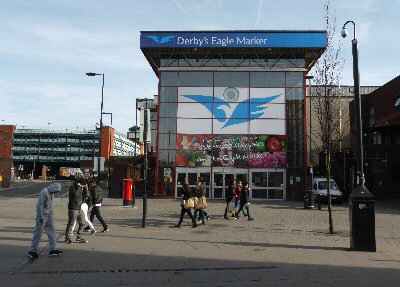
Three years after work started to build a new shopping centre, the Eagle Centre ceased to exist being renamed the Westfield (now Intu). It opened its doors to the public on 9 October 2007. However, the Eagle Market was not part of the redevelopment and retained its original name.
The prestigious new centre, with sleek floor-to-ceiling glass fronts, changing mood lighting and the logos of top shops visible from every angle, was an instant success with most shoppers. When it opened it housed more than 150 outlets spread over a total of 105,800 square metres of floor space, it had an 800-seater food court and a 3,700-space multi-storey car park on the roof. Two thousand eight hundred and fifty jobs were created and the development was expected to attract inward investment to the city from investors who previously would not have considered Derby. The Eagle Centre is to be replaced.
Derby Theatre
Derby Playhouse was offered the site in the Eagle Centre by the City Council, as part of the new shopping development and was officially opened on 20 September 1975 by the Duke of Devonshire. The original Playhouse had opened as the Little Theatre in Becket Street, in a converted Church Hall in 1948. Four years later it moved to converted premises on Sacheverel Street. Surviving a major fire in 1956, it became an important part of Britain’s regional theatre network. Arts funding increased considerably in the 1960s and 1970s enabling the theatre to afford purpose-built premises in the Eagle Centre. However, following a period of financial problems, the theatre was forced to close but re-opened again in 2009 under the control of Derby Live. Now known as Derby Theatre, the theatre is involved in a unique partnership with the University of Derby and the Arts Council of England. This has resulted in the theatre being transformed from a traditional producing house into an organisation of training, mentorship and artistic excellence.

